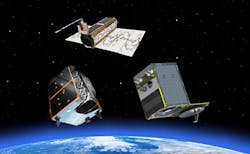Wanted: companies to build spacecraft, sensor payloads, and on-board data processing for small satellites
Officials of the U.S. Intelligence Advanced Research Projects Agency (IARPA) in Washington have released a request for information (IARPA-RFI-19-05) for Innovative Technologies for Small Satellites project. IARPA experts want information on innovations in space-based research to mature the state of the art for smallsats.
This RFI is asking industry for capability statements on smallsats, subsystem technologies, and data collection and processing capabilities that are assessed to be at Technology Readiness Levels 1 to 6. IARPA is the research arm of the U.S. Office of the Director of National Intelligence.
Small satellites have a mass less than 1,102 pounds (500 kilograms), and are for low-cost applications with two-to-three-year delivery times from concept to launch. IARPA is seeking further reductions of the cost, risk, complexity, mass, and time to launch of small satellite technologies.
IARPA is asking industry to identify candidate smallsats technologies with game-changing potential, and validate these technologies in space or in a laboratory space simulation. Technologies must demonstrate capabilities not previously demonstrated with smallsats or in space.
IARPA also is trying to accelerate improvement or create new smallsat capabilities in machine autonomy, advanced communications, remote observation, space-based sensors, automated data processing, object recognition, or other on-board data processing and distribution capabilities. In addition, IARPA is asking industry to identify key technologies that incubate and enhance the market for smallsats.
Enabling technologies of interest include temporal and spectral imaging; synthetic aperture radar; artificial intelligence (AI); machine learning; on-board processing for payload and communications applications; RF and optical payload technologies; data fusion; complete spacecraft and smallsat constellations; command and data handling; mission operations; thermal management and cooling; power; propulsion; navigation; and autonomous operations.
Companies interested should email 10-page white papers in .PDF format no later than 31 May 2019 to IARPA at [email protected].
Email questions or concerns to IARPA's Torreon Creekmore at [email protected]. More information is online at https://www.fbo.gov/notices/c9ba24de15368045140df1a12bf58c09.
Ready to make a purchase? Search the Military & Aerospace Electronics Buyer's Guide for companies, new products, press releases, and videos

